
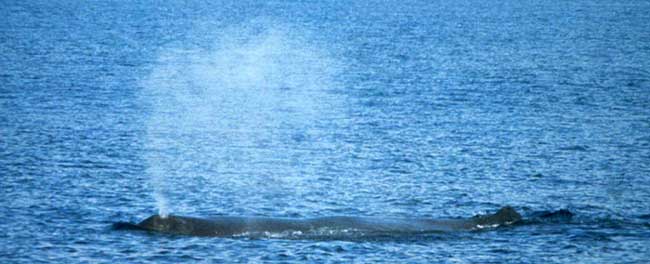
This page talks about cetaceans of the deep ocean, often well offshore
and beyond the parameters of Monterey Bay. All are toothed whales that
feed to some extent on squid; the Sperm Whale specializes in giant squid.
Because their lives are spent far offshore and they can stay underwater
for long periods, it is rare to see any of the whales on this page although
all may be present here year-round. All photos taken in Monterey Bay,
Monterey County, or offshore (except the pair of Ziphius).


| The
Great Sperm Whale Physeter macrocephalus (both photos
above and right) is a huge deep-diving toothed whale; it is the "Moby Dick"
of literature. Lone individuals or small pods dive for squid in the deep
oceans around the world. Their giant head is filled with spermaceti, a
reservoir of high-quality oil-like wax for which the whales were relentlessly
hunted for "whale oil." There is only a rude ill-formed lump for a dorsal
fin and the skin is textured with wrinkles and ridges.
Giant Sperm Whales can dive to over 1000m deep, and can stay down for over an hour. When they surface, the whales lolygag on the surface like huge downed logs; their exhaled blows — canting off to the left — can be seen for miles. They are generally gregarious, with groups up to 50 sometimes seen, but large males may be found alone. As they spend so much time underwater and they are well offshore, it is always an extraordinary treat to see one on a pelagic trip. |
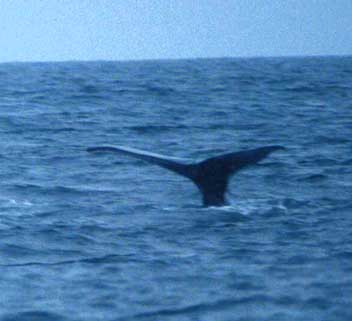 |
| Another remarkable toothed whale is Baird's Beaked Whale Berardius bairdii (next five photos). These are the largest of the beaked whales, and can grow up to 40 ft in length. They travel in pods of up to 20 animals. Adults are often heavily scarred. | 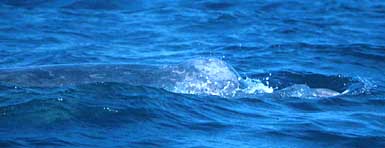 |
| These whales are slaty-gray in color. They have a prominent, bulging forehead (above right), a long cylindrical beak (near right) and a broad tail (far right). The beak is clearly demarcated from the head, and tipped with white where teeth protrude. | 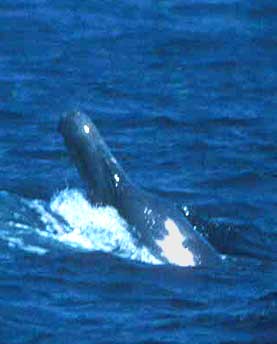 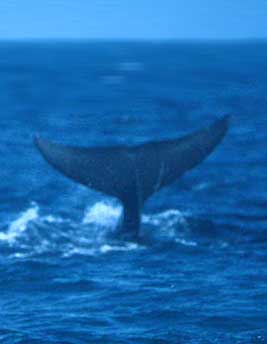 |
| When groups are lying on the surface without their dorsal fins showing
(above right), they recall pods of small Sperm Whales, but then the prominent
dorsal fins (bottom right) reveal their true character.
Baird's Beaked Whales are found annually in Monterey Bay, usually in
summer and fall. Their overall numbers, though, seems small and thus it
is a rare treat to come upon a pod of them. They have a low, indistinct,
broad blow. Little is known about their life history, although they apparently
eat squid, deep-sea fishes, and crustaceans. They can dive for up to 40
minutes, and then often resurface at the same spot.
|
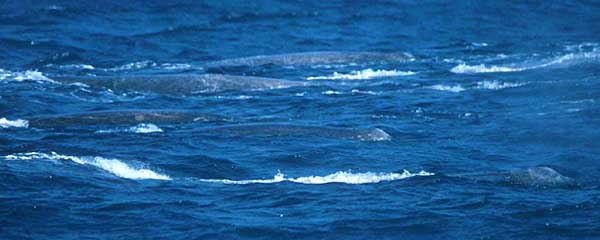
|
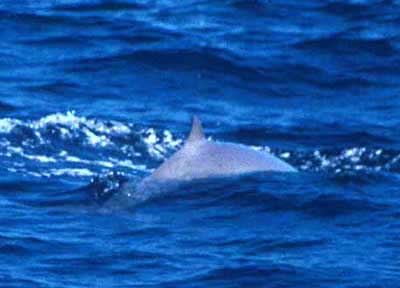 |
Even less often encountered than Baird's Beaked Whale is Cuvier's Beaked Whale Ziphius cavirostris (left and below), sometimes called "Goose-beaked Whale" but often just known as "Ziphius" to cetacean-people (it is a monotypic genus). Ziphius is found around the globe but seems to be everywhere spread rather thinly. Adults are in the 20 ft size range, and the beak is shorter than other beaked whales. There is a single pair of conical teeth at the tip of the snout. |
| Cuvier's Beaked Whales are variable in many respects. Body color can
range from tan to reddish is young whales, changing to dark gray as they
mature (but often with many scratches on their bodies), and old whales
are either dark with whitish heads (females) or whitish all over (males).
The pair shown at right, which I photographed in the eastern tropical Pacific,
seem likely to be an adult female (front) and an old male. The whale photographed
in Monterey Bay (above) may be a youngster.
Cuvier's Beaked Whales are also variable in dorsal fin shape, for high and falcate (above) to low and broad (right). Based on strandings, this whale is distributed from the Bering Sea to the Equator, and therefore is comfortable in nearly any temperature. They are apparently deep divers that prey on squid and deep-sea fishes. In Monterey Bay, most of the few sightings are from waters beyond the continental shelf. |
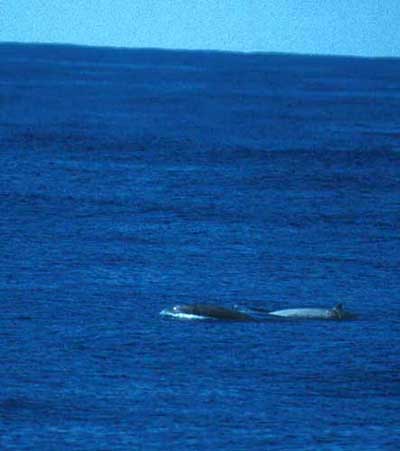 |
Compared to the 35-40 foot Baird's Beaked Whale and the 18-25 foot Cuvier's Beaked Whale, the various species of 8-15 foot beaked whales in the genus Mesoplodon are both mysterious and difficult to identify in the field. Very little is known about these fascinating animals with their enigmatic distribution. They are rarely seen at sea and much of what is known about distribution comes from strandings. When found at sea they come in singles, pairs, or small groups. Males have emergent teeth that help identify them but females and youngsters can be difficult. Part of the problem is just getting a decent view. Usually it takes a very calm day on the sea to even spot a Mesoplodon, and then getting close enough for views has been hard. They are almost always over deep water beyond the continental shelf, where they presumably dive for squid. I've yet to identify any in 30 years of Monterey Bay boat trips (I have seen just one sp?), although I was able to identify a couple species during tropical Pacific research cruises.
According to the now quite-dated Leatherwood et al. (1982), the species known from Monterey County — all from strandings — were Hubbs's Beaked Whale Mesoplodon carlhubbsi and Stejneger's Beaked Whale M. stejnegeri . The tropical species, Dense-beaked Whale M. densirostris, has came ashore on a San Mateo Co. beach to the north, so it also must occur in our offshore waters. Ginkgo-toothed Beaked Whale M. ginkgodens has been stranded in southern California. Recent research, including biochemical work, has discovered that a few beaked whales stranded in California, including one in Monterey on 18 Sep 1997, are a new species: Perrin's Beaked Whale M. perrini (Dalebout et al. 2002). Four of these from southern California had initially been thought to be Hector's Beaked Whale M. hectori (e.g., Leatherwood et al. 1982), a species now thought to be confined to subantarctic oceans. The Monterey specimen had initially been thought to be a baby Cuvier's Beaked Whale. Perrin's Beaked Whale is thought to be related to the Lesser (or Pygmy) Beaked Whale M. peruvianus of the eastern South Pacific, with Perrin's Beaked Whale occurring in the eastern North Pacific. Monterey Bay Whalewatch and other outlets sell a waterproof card that illustrates all eastern North Pacific species very well (Folkens 2000). I presume that the unidentified Mesoplodon pictured on the card as "(California) Beaked Whale M. sp?" is that whale now described as Perrin's Beaked Whale M. perrini.
I can show you photos of two stranded Beaked Whales from Monterey County: Both strandings have been of young (maybe even baby) beaked whales without the emergent teeth shown by adult males.
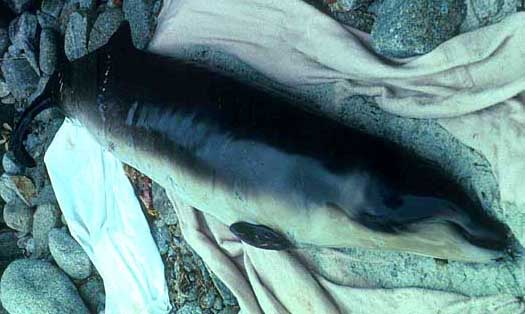 |
This M. stejnegeri was stranded in the little cove at the foot of Seapalm Ave. in Pacific Grove on 21 May 1990. I was able to take this photo before it was removed to Moss Landing Marine Lab for research through the courtesy of Alan Baldridge, who called me about this rare occurrence. At the time we thought it was likely a carlhubbsi, but apparently an autopsy and detailed analysis found otherwise. |
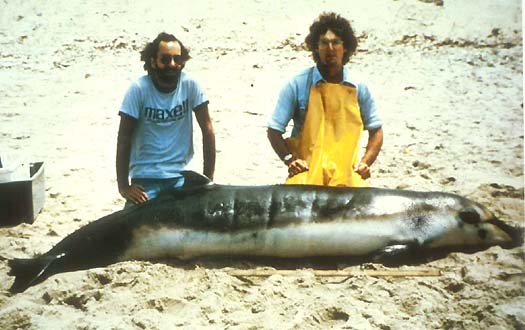 |
This M. carlhubbsi was on a Monterey County beach sometime in the 1980s (this and next photo © Frank Cippriano). You can get a good idea of the small size, the short beak with "smile," and the dramatic patterns on these whales. [It is duly noted that the identification in various data bases for this baby says i.d. as carlhubbsi is probable, but not conclusive.] |
| In this close-up of the head of the (probable) baby Hubbs's Beaked Whale (same whale as just above), note the black eye patch and the black crown stripe that continues down the beak to include the beak. On your next visit to the Monterey Bay Aquarium, look for a life-sized version of this rare whale — with all these distinctive patterns — hanging from the ceiling among other Monterey Bay cetaceans [hint: its near the live Sea Otter grotto]. |  |
Mesoplodon beaked whales remain the rarest and least understood cetaceans in Monterey Bay and offshore waters. It is also worth noting that there are probably more species to be described in this genus. Eleven species were listed by Rice (1977) but some 14 species are listed in Dalebout et al. (2002). Yet there is another tropical Mesoplodon that was been observed multiple times, and has been photographed (Pitman et al. 1987), that has not yet been formally described as none has ever been collected or found stranded. I had the good fortune to see that "no-name" Mesoplodon in the eastern tropical Pacific in 1989.
Literature cited:
Dalebout, M.L., J.G. Mead, C.S. Baker, A.N. Baker, and A. L. van Helden. 2002. A new species of beaked whale Mesoplodon perrini sp. n. (Cetacea: Ziphiidae) discovered through phylogenetic analyses of mitochondrial DNA sequences. Marine Mammal Science 18: 577-608.Click on the links below to bring up the photo-intensive pages which feature:Folkens, P. 2000. Marine Mammals of the Eastern North Pacific: a concise and comprehensive waterproof guide. Monterey Bay Whale Watch & Alaska Whale Fnd.
Leatherwood, S., R.R. Reeves, W.F. Perrin, and W.E. Evans. 1982. Whales, Dolphins, and Porpoises of the Eastern North Pacific and adjacent Arctic Waters: A Guide to Their Identification. NMFS, NOAA, U.S. Dept. Commerce, NOAA Technical Report NMFS Circular 444.
Pitman, R.L., A.L. Aguago, and J.R. Urbán. 1987. Observations of an unidentified beaked whale (Mesoplodon sp.) in the eastern tropical Pacific. Marine Mammal Science 3: 345-352.
Rice, D.W. 1977. A list of the marine mammals of the world. NMFS, NOAA, U.S. Dept of Commerce. NOAA technical rept. NMFS SSRF-711.
|
|
|
|
|
|
|
|
|
|
|
|